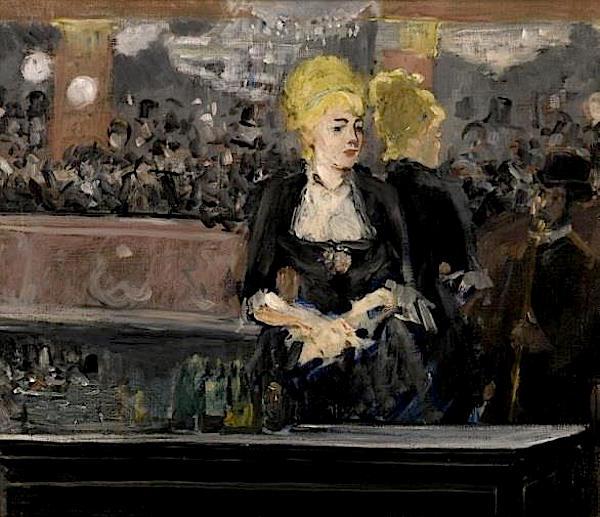A study of ‘Le Bar aux Folies-Bergère’, one of the best known works by the artist Edouard Manet, is to go under the hammer at Sotheby’s. The primary painting owned by the Courtauld Gallery, London is one of the most iconic subjects by the artist. This first version is offered for sale following its recent showing at The National Gallery’s ‘Inventing Impressionism’ exhibition.
Helena Newman, Sotheby’s Co-Head of Impressionist & Modern Art Worldwide“In his celebrated evocation of the Folies-Bergère scene, Édouard Manet produced from an everyday setting an iconic image of modern Paris. This is one of only two paintings by Manet of the Folies-Bergère – the other housed at the Courtauld Gallery in London – and therefore the only version remaining in private hands. Following its illustrious appearance at the National Gallery, we very much look forward to exhibiting this outstanding painting at Sotheby’s prior to its sale.”
Le Bar aux Folies-Bergère of 1881 by Manet was procured by Paul Durand-Ruel. The painting was shown to the public in 1905 in the now legendary exhibition at the Grafton Galleries, London, which introduced the British public to Impressionism. Testament to its outstanding quality, it has since been exhibited extensively internationally; reflecting its importance and provenance Le Bar aux Folies-Bergère most recently featured as one of the highlights of the National Gallery’s blockbuster exhibition in London Inventing Impressionism: Paul Durand-Ruel and the Modern Art Market – a high note upon which the show ended. The painting will be on view at Sotheby’s in London from 19th – 24th June 2015.
Manet turned to the theme of bars and café-concerts in the late 1870s as inspiration for his paintings, which reached a climax in the subject depicted in Le Bar aux Folies-Bergère. His celebrated large-scale oil of the same title, exhibited at the Salon of 1882 and now in the collection of the Courtauld Gallery, London, is considered the crowning achievement of Manet’s career.
While the two related paintings share the same subject and a similar composition, the artist’s stylistic approach to painting them differed significantly. Unlike the painting in the Courtauld, this smaller, earlier painting (47 by 56cm) displays a remarkable vivacity and immediacy in the artist’s depiction of his subject, and is executed with quick, spontaneous brushstrokes that remained barely altered as Manet developed the composition.
In the mid-1980s X-ray-based research revealed further differences in approach and techniques employed. Interestingly, beneath the surface of the Courtauld painting lies a composition that resembles the earlier painting much more closely. Manet initially transferred the composition of the earlier work to the larger canvas, and over a longer period of time made numerous changes that led to the final image: he enlarged the figure of the barmaid and depicted her in the centre of the composition frontally, replacing her clasped arms with straight ones and moving the barmaid’s reflected image to a less logical position on the right, whereas the image of her male companion was moved further up into the top right corner. In the process Manet substituted the immediacy of the earlier painting – in which reality is transcribed with a wonderful vibrancy and freedom – for a composition in which the reflections of the two figures become picturesque but implausible.
The Folies-Bergère, a Parisian variety theatre, was opened in 1869 on the rue Richer. It offered a combination of pantomime, ballet, acrobatics and music, with many bars “tended by charming girls whose playful glances and delightful smiles attract a swarm of customers”, according to one contemporary account. Manet made various sketches there, and the painting to be offered was based on an ink sketch depicting a barmaid engaged in a conversation with a man, both figures reflected in the mirror behind her.
Le Bar aux Folies-Bergère remained with the artist until his death when it was inherited by his widow, Suzanne Manet (née Leenhoff). It was subsequently given to Edmond Bazire, a friend of Manet’s who had written the first monograph on the artist’s work in 1884. The painting was eventually procured by Paul Durand-Ruel from whom the renowned Viennese art collector Dr Hermann Eissler acquired the painting. In 1928 Franz Koenigs, one of the leading collectors of his day, bought the work through the Amsterdam branch of Paul Cassirer’s dealership, which had it on consignment from the estate of Dr Eissler’s brother Dr
Édouard Manet’s Le Bar aux Folies-Bergère is estimated at £15-20 million / $23-30.7 million / €21-28 million. The painting remained in the artist’s personal collection up until his death, after which his famed dealer Gottfried Eissler. While much of Koenigs’ collection is now housed in Rotterdam’s Museum Boymans, this painting by Manet remained in the family’s own personal collection until 1994 when it was last sold at Sotheby’s London for £4.4 million. It was later acquired by the present owner.

